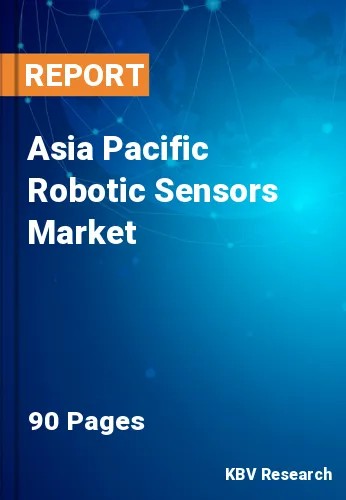The Asia Pacific Robotic Sensors Market would witness market growth of 10.7% CAGR during the forecast period (2022-2028).
IR circuits are created using the triangulation concept to estimate distance. When an obstacle is present, a transmitter transmits a pulse of IR signals that the receiver detects. Depending on the angle where the signal is collected, distance is estimated. The task of measuring distance can still be accomplished with a basic broadcast and receive utilizing a few transmitters and receivers, but if accuracy is needed, choose the triangulation approach.
A GPS seems to be the positioning sensor that is most frequently utilized. Signals are transmitted by satellites in orbit, and a robot's receiver receives and interprets these signals. The data that has been analyzed could be utilized to estimate a robot's position and speed. Robots operating outdoors benefit greatly from such GPS systems, but they are useless indoors. They are now a bit pricey as well, but if that changes, very soon the majority of robots will have a GPS module connected.
Comparable to a portable magnetic compass, a digital magnetic compass uses the earth's magnetic field to generate directional measurements that direct the robot toward its target. Such sensors are less expensive than GPS modules, but if individuals need both positional feedback & navigation, a GPS module works best when combined with one of these sensors.
As sensor works to enhance robotics components and increase the usage of smart machines in various industries, China hopes to become a global leader in robotics innovation by 2025. According to experts, the action is a component of the nation's bigger initiative to address the issue of an aging population and use cutting-edge technologies to promote industrial modernization. According to a five-year plan released on December 28 by the Ministry of Industry and Information Technology, China's robotics industry is expected to grow at an annual rate from 2021 to 2025. China has been the world's top manufacturer of industrial robots for the past eight years.
The China market dominated the Asia Pacific Robotic Sensors Market by Country in 2021, and would continue to be a dominant market till 2028; thereby, achieving a market value of $313 million by 2028. The Japan market is estimated to grow a CAGR of 10% during (2022 - 2028). Additionally, The India market would experience a CAGR of 11.3% during (2022 - 2028).
Based on Vertical, the market is segmented into Manufacturing, Logistics, Aerospace & Defense, Healthcare, and Others. Based on Type, the market is segmented into Force (Torque) Sensor, Proximity Sensor, Position Sensor, Vision Sensor, Temperature Sensor, and Others. The report also covers geographical segmentation of Robotic Sensors market. Based on countries, the market is segmented into China, Japan, India, South Korea, Singapore, Malaysia, and Rest of Asia Pacific.
Free Valuable Insights: The Worldwide Robotic Sensors Market is Projected to reach USD 3.1 Billion by 2028, at a CAGR of 10.2%
The market research report covers the analysis of key stake holders of the market. Key companies profiled in the report include TE Connectivity Ltd., Infineon Technologies AG, Omron Corporation, Honeywell International, Inc., ATI Industrial Automation, Inc., FANUC Corporation, Sensata Technologies Holdings PLC, Baumer Holding AG, Tekscan, Inc., and FUTEK Advanced Sensor Technology, Inc.
By Vertical
By Type
By Country
Our team of dedicated experts can provide you with attractive expansion opportunities for your business.

